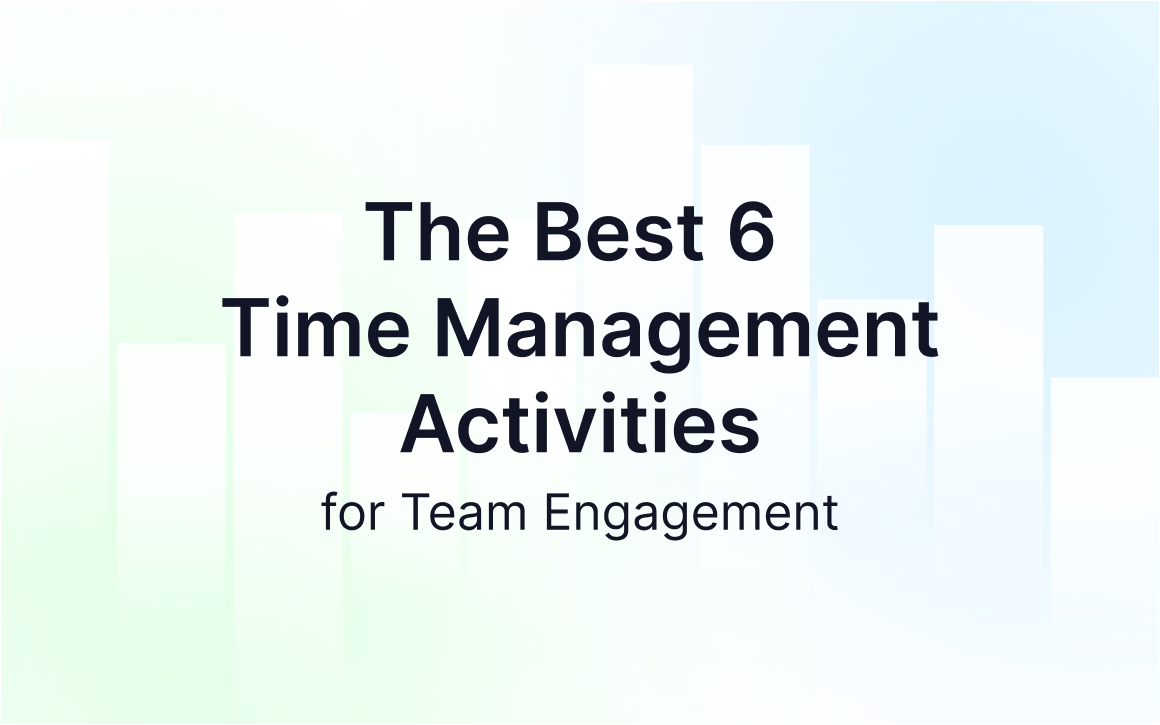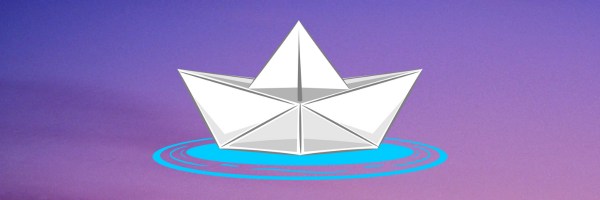The Best 6 Time Management Activities for Team Engagement
This is a list of the best 6 time management activities and games to effectively foster team participation and performance. They are ideal when it comes to increasing engagement in a team.

Learning how to manage time does not have to be a routine procedure.
Say goodbye to languishing lectures!
In this article, you will discover the most interesting secret weapon for enhancing the efficiency and motivation of your team: time management games and activities.
These games are more than entertaining and engaging. They are also effective means to:
- Polishing personal talents
- Building teamwork
- Creating a beneficial working atmosphere.

Interactive Time Management Games & Team Activities
Paper Boat Regatta
Collaboration Skills Training

It is an excellent activity to promote cooperation, distribution of resources, and meeting deadlines, under the guise of the competition!
Materials🔬
- Large sheets of construction paper (or newspaper)
- Masking tape
- Scissors (optional, they will be used for creative cutting)
- Pens, markers, or crayons (optional, it is for decoration)
- A large tub or basin of water
- Weights (even nuts will do, or take small objects of similar weight)
Instructions📄
Divide the Team🚣 Divide the participants into small groups of 3-5 people.
Set the Challenge🏆 Tell each team that they will be building a paper boat that must hold the most weight within a time limit (e.g., 15 minutes).
Resource Allocation🔧 Give each group several sheets of construction paper, a roll of masking tape, plus other decorative materials.
Building Phase🔩 Let the creativity keep them aboard (literally)! Teams can design and build their boats – you need to encourage them to discuss strategies and delegate tasks effectively.
Decorate (Optional)🎉 If time allows, the decoration of the paper boats for extra fun and team spirit is welcome.
The Regatta!🌍 Once the time limit is up, the next meeting point is the tub or basin filled with water. Each team will place their boat in the water and slowly start adding the weights (one at a time) until their boat sinks.
Declare the Winner! 👏The team whose boat holds the most weight before sinking is the champion of the Paper Boat Regatta!
Debrief (Optional)
The activity should be discussed after the competition, when everyone can be gathered.
You may ask:
What were the difficulties your build team encountered?
How did you speak and share tasks with the team?
Which designs do you believe assisted your boat in carrying the maximum weight?
Additional Tips
- You can set a size limit on the boats to make it more fun.
- If your group is big, you can have many rounds of the Regatta with different teams in each round.
- To go all out on the sea theme, let the teams pick fun names for their boats.
Kanbanize It: Work Process Board Challenge
Project Management Skills Training

Each team will compete to create the most optimized Kanban board for a specific work process scenario.
Materials🔬
- Whiteboard or large sheet of paper (Kanban canvas)
- Markers or pens
- Sticky notes (different colors for flair!)
Instructions📄
Each group will make the best Kanban board. The task will be announced after the start of the game.
Kanban 101▶️ Start with a quick reminder on how Kanban boards work (These boards show tasks in steps like "To Do," "In Progress," and "Done.")
Team Up! 👯 Make small groups of 3-5 people.
The Scenario ✍️ Each group gets a work task set. It could be about your real job (like handling orders or making a product) or imaginary tasks (for fun).
Building Your Board 🎬 On your board or paper, draw your Kanban board with three parts: "To Do," "In Progress," and "Done."
Sticky Situation📎 Use your sticky notes! Write each task on a note.
Workflow Simulation🏂 Put your tasks in the right parts. Think about how much work time and effort each task needs and how tasks depend on each other.

Optimization Time!🕐 Now, look for ways to make your task flow better. This might mean moving tasks around, changing who does what, or spotting areas that need work.
Revised Workflow💡 Show your new, better task flow on your board. Move or add notes as needed.
Presenting Your Masterpiece✨ After the preparations are over, bring all groups together. Each group will show their Kanban board and talk about their boards.
Kanban Champions!🏆 The group with the clearest, best-flowing, and easiest-to-apply Kanban board will win the title of Kanban Champions!
Time Perception Challenge
Training Time Allocation

It is a quick and thought-provoking icebreaker.
Why play it? It will get people thinking about the subjectivity of time perception.
Materials🔬
- None Required
Instructions📄
Start it Off✅ Talk a bit about the game, saying it's all for checking how we think about time. Say there are no right or wrong picks.
Quiet Minute⏰ Let everyone get cozy and shut their eyes. Tell them to keep their eyes closed and not look at any clocks.
Look Now👀 Say, "Open your eyes when you feel like a minute has gone by."
Time Gaps📈 Once some have opened their eyes, wait a little to let all have a go. Then, ask:
- How long do you think it actually was?
- Were some people surprised by how long (or short) it felt?
Reveal the Actual Time and Start Discussion🔍 Have a discussion about the differences in perception.
Here are some prompts.
1️⃣What can influence how long a minute feels? (e.g., anticipation, boredom, activity level, the weather)
2️⃣Have you ever experienced time slowing down or speeding up? When?
3️⃣How can it help to 'understand' the time in daily life?
Time Management Priority Blocks
Polishing Prioritization Skills

Materials🔬
- A hat or bowl
- Small slips of paper (they must have project names based on your specific teamwork)
- Colored blocks or construction paper cut into squares (Disclaimer: they will be used to visualize priorities)
- Markers or pens
- Timer
Instructions📄
Project Draw🗳️Divide the participants into small groups of 3-5 people. Each team names a captain who will be presenting a group later. Place the slips of paper in a hat or bowl.
Project Selection⭐ Instruct each team to draw a project name from the hat. This will be the project they will prioritize with the colored blocks.
Priority Block Building (3 Minutes)⭐ Set a timer for 3 minutes. Distribute the colored blocks and markers to each team. Within the time limit, each team needs to work together to create a set of blocks and represent the priority breakdown for the project.
Color Legend🖍️ Before starting, establish a color legend together. For example:
1️⃣Red: High Priority Tasks (urgent and critical)
2️⃣Yellow: Medium Priority Tasks (important but not urgent)
3️⃣Green: Low Priority Tasks (less important or can be delegated)
Building the Blocks▶️ Teams need to talk about the project and pick what tasks matter most. They will then use colored blocks to show these important tasks. For instance, a big red block could stand for a very important task, while smaller yellow blocks might be for tasks that aren't as urgent.
Captain's Explanation👨💼 Once the timer goes off, each team captain gets a chance to present their team's creation. They should explain the project they drew and the rationale behind their color choices for each block. Encourage them to discuss:
1️⃣Why certain tasks were prioritized as red (high) or yellow (medium).
2️⃣How they decided on the relative size and number of blocks for each color.
Debrief and Discussion💡 After all the presentations, have a group discussion. Here are some prompts to get the conversation started:
1️⃣Were there any surprising choices made by other teams?
2️⃣Did any teams face challenges in defining priorities?
3️⃣How can this activity be applied to real-world project management?
Additional Tips
- You can adjust the time limit based on the complexity of the projects.
- For a larger group, have multiple rounds with different teams drawing projects.
- Consider adding a "bonus block" category (e.g., blue) representing unforeseen obstacles or interruptions. This can further emphasize the importance of flexibility in setting task priorities properly.
Time Bandit Busters
Identifying Time Wasters

This fast-paced activity will have your team working together to identify and eliminate time wasters specific to a chosen profession.
Materials🔬
- Whiteboard or online collaborative tool (e.g., Miro, MURAL)
- Markers or pens (if using a whiteboard)
- Sticky notes or virtual sticky notes (for remote teams)
Instructions📄
Profession in the Spotlight ⭐ Divide participants into small groups of 3-4 people. Each round will focus on a specific profession you'll reveal shortly.
Simultaneous Brainstorm 🧠 Set a timer for 1 minute. Instruct all teams to brainstorm and list as many potential time wasters as possible for a specific announced profession. Encourage them to think creatively!
Focus on Uniqueness🤩 Emphasize that the goal is to identify unique time wasters that others might not have considered. The more specific and detailed their time wasters, the better.
Time Waster Showdown✍️ Once the timer goes off after 2 minutes, stop all brainstorming. This is the showdown round!
List Comparison📋 Instruct each team to compare their list of time wasters with the lists of other teams. Teams can walk around the room (if in person) or use the online collaborative tool to view each other's lists.
Highlighting Uniqueness🔍 Set another timer for 2 minutes. Each team will now review their own list and eliminate any time wasters already mentioned by other teams. The goal is to have the most unique time wasters remaining on their list. Encourage them to refine their list, adding specifics or merging similar ideas.
Showdown Presentations 📢(2 Minutes per Team): After the time limit, have a representative from each team present their final list of unique time wasters for the chosen profession.
The Time Waster Champions! 🏅Once all presentations are complete, discuss the time wasters as a team. Celebrate the team that identified the most unique and interesting time-wasters!
Debrief and Discussion (Optional)
- How did brainstorming simultaneously influence your approach?
- What surprised you about the common time wasters for graphic designers?
- How can your team apply the identified time wasters to their own work habits, even if not directly related to graphic design?
Additional Tips
- You can do this task many times, each round with a new job in mind.
- To make it more fun, let teams draw mind maps or charts to show what eats their time.
- If your team is not in the same place, use online tools that let you share screens to show each other's lists.
3 Strategies for a Connected Hybrid Team
As a hybrid team manager, it is important that you consider team-building practices that can connect and make all your workers, both virtual and physical, cooperate.
When the team building is participative, it helps you to fill up the space between members of the team and make the environment unified.
Shared Experiences
Conferences and Workshops: Make a special effort to organize group outings to industry events or professional development workshops to get out of the office and have a lot of fun while still maintaining the spirit and quality of your team.
Online Team-Building Exercises: In case of people who cannot make it to an in-person event, virtual team-building exercises can be offered instead: Online escape rooms, cooking sessions, or trivia contests, etc.
Tangible Connections
Individualized Swag: Branded apparel for any employee on the team, wherever their location is.
Company-Level Efforts: Coordinate virtual or in-person, company-level events, which may be a holiday party or a volunteer activity.
Collaborative Activities
Problem-Solving Exercises: During the meetings, engage in collaborative tasks, like brainstorming sessions, group problem-solving tasks, or team-based games.
Knowledge Sharing Platforms: Use online platforms, wikis, or forums that will facilitate collaboration and sharing of information by promoting the sharing of knowledge.
Speed Ship with TMetric Data
Ideal Time Management Activity for Retrospectives

This activity uses TMetric data to conduct a productive retrospective with a nautical twist!
We'll identify factors that help your team sail smoothly and those that create choppy waters.
Materials🔬
- Whiteboard or online board (e.g., Miro, Mural)
- Sticky notes
- Access to TMetric Reports
Instructions📄
Gather TMetric Data🔍📈Pull TMetric reports for team activity. Focus on reports that show time spent on projects, tasks, or apps.
Set Up the Board✅Divide the board into two sections: "Fair Winds" and "Rough Seas."
Introduce the Activity✨ Briefly explain that "Fair Winds" represent activities, tools, or processes that help the team work better, while "Rough Seas" represent things that slow them down.
Individual Reflection🤔 Encourage each team member to consider for 5 minutes:
- Tasks that felt time-consuming.
- Tools or processes that helped them complete tasks quickly.
- Repeated roadblocks or delays.
Provide sticky notes and ask them to write down factors impacting their sailing (work experience). Remember:
- Fair Winds🪂 Things that make them work faster (e.g., efficient tools, clear communication).
- Rough Seas🌪️ Things that slow them down (e.g., context switching, unclear instructions).
Sharing and Grouping↗️ Have everyone take turns placing their sticky notes on the corresponding board sections ("Fair Winds" or "Rough Seas"). Group similar notes together to identify common themes.
Discussion💡Set a timer for 20 minutes. First, talk about the points under "Fair Winds." Think of ways to use these points to make the team work better. Next, go over the points listed under "Rough Seas." Check the time data (if you can) to find where time goes to waste. Look for trends in the apps used, jobs that take too long, or often changing.
Charting a New Course🗺️ As a team, brainstorm solutions to address the "Rough Seas" items. Consider delegating tasks, automating repetitive processes, or improving communication channels.
Follow-up 📂Assign ownership and deadlines for implementing solutions. Schedule a follow-up meeting to discuss progress.
Remote Teams
- This activity works well for remote teams. Use a collaborative online whiteboard tool like Miro or Mural for brainstorming and grouping notes.
- If not using TMetric, encourage participants to rely on their own time management techniques (e.g., time logs) when reflecting on their work.
Additional Tips
- Encourage open and honest participation.
- Focus on solutions, not blame.
- Celebrate team wins and identify areas for continuous improvement.
Conclusion
Boost team fun with time games and tasks to:
Up work speed
Make the job satisfaction go up
Build a happier workplace.
Add these cool time games to make teams get new and useful skills while they have fun.


